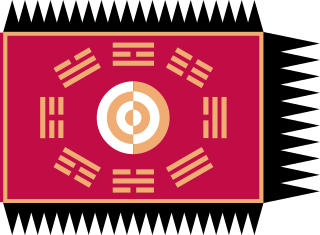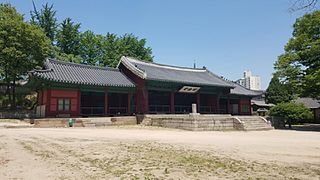This page is based on this
Wikipedia article Text is available under the
CC BY-SA 4.0 license; additional terms may apply.
Images, videos and audio are available under their respective licenses.

Joseon dynasty was a Korean dynastic kingdom that lasted for approximately five centuries. It was founded by Yi Seong-gye in July 1392 and was replaced by the Korean Empire in October 1897. It was founded following the aftermath of the overthrow of Goryeo in what is today the city of Kaesong. Early on, Korea was retitled and the capital was relocated to modern-day Seoul. The kingdom's northernmost borders were expanded to the natural boundaries at the rivers of Amnok and Tuman through the subjugation of the Jurchens. Joseon was the last dynasty of Korea and its longest-ruling Confucian dynasty.

Kaesong is a city in North Hwanghae Province in the southern part of North Korea, a former Directly Governed City and the capital of Korea during the Taebong kingdom and subsequent Goryeo dynasty. The city is near the Kaesong Industrial Region close to the border with South Korea and contains the remains of the Manwoldae palace. Called Songdo while it was the ancient capital of Goryeo, the city prospered as a trade centre that produced Korean ginseng. Kaesong now functions as the DPRK's light industry centre.

Suwon is the capital and largest metropolis of Gyeonggi-do, South Korea's most populous province which surrounds Seoul, the national capital. Suwon lies about 30 kilometres south of Seoul. It is traditionally known as "The City of Filial Piety". With a population close to 1.2 million, it is larger than Ulsan, although it is not governed as a metropolitan city.
Education in the Joseon Dynasty of Korea was largely aimed at preparing students for government service. The ultimate goal of most students was successful passage of the state examinations, known as gwageo.
The Gukjagam, known at times as Gukhak or Seonggyungwan, was the highest educational institution of the Korean Goryeo dynasty. It was located at the capital, Gaegyeong, and provided advanced training in the Chinese classics. It was established in 992 during the reign of Seongjong. Its name has been changed to Songgyungam in 1298 and to Songgyungwam in 1308. Its current name is Koryo (/Goryeo) Songyungwam University/University of Light Industry. A similar institution, known as the Gukhak, had been established under Unified Silla, but it was not successful.

Seowon were the most common educational institutions of Korea during the mid- to late Joseon Dynasty. They were private institutions, and combined the functions of a Confucian shrine and a preparatory school. In educational terms, the seowon were primarily occupied with preparing students for the national civil service examinations. In most cases, seowon served only pupils of the aristocratic yangban class.
This is a partial list of Korea-related topics beginning with K. For Korean words starting with ㄱ, see also under G.
This is a partial list of Korea-related topics beginning with S.
The gwageo or kwago were the national civil service examinations under the Goryeo and Joseon dynasties of Korea. Typically quite demanding, these tests measured candidates' ability of writing composition and knowledge of the Chinese classics. The form of writing varied from literature to proposals on management of the state. Technical subjects were also tested to appoint experts on medicine, interpretation, accounting, law etc. These were the primary route for most people to achieve positions in the bureaucracy.

Daehangno is a neighborhood in Seoul north of the Han River within Jongno-gu and Seodaemun-gu.

Munmyo is Korea's primary temple of Confucius. Munmyo baehyang was the highest honor a scholar could achieve during the Joseon. Only eighteen people were granted this honor; they are called the "Eighteen Sages of Korea" or the "Eighteen Confucian Scholars of the East". It is located in central Seoul, South Korea, at 53 Myeongnyun-dong 3(sam)-ga, Jongno District, on the campus of Sungkyunkwan University.

Jongno District (Jongno-gu) is a gu, or district, in central Seoul, South Korea. It takes its name from a major local street, Jongno, which means "Bell Street".

Crown Prince Hyomyeong, born Yi Yeong, or Lee Yeong, and posthumously called King Munjo, was a prince of the Joseon Dynasty.
Hyehwamun is one of the Eight Gates of Seoul in the Fortress Wall of Seoul, South Korea, which surrounded the city in the Joseon Dynasty. The gate is also known as Dongsomun.
The following is a timeline of the history of the city of Seoul, South Korea.

The Seokjeon Daeje, also sometimes called Seokjeonje, is a ceremonial rite performed twice annually to honor Confucius. It is held at Confucian sites across South Korea including hyanggyos and the Confucian temple Munmyo located at Sungkyunkwan, on Confucius' birthday in fall and the anniversary of his death in spring. Seokjeon is made up of the two Chinese characters, 釋 and 奠 (alcohol), and Seokjeon Daeje means "Laying out offerings ceremony". It involves an elaborate ceremony with sacrificial offerings of alcohol and foods, as well as an elaborate dance known as munmyo ilmu accompanied by musical performances munmyo jeryeak. Ceremonies honoring Confucius date back to 372 in Korea, during the Three Kingdoms Period.











